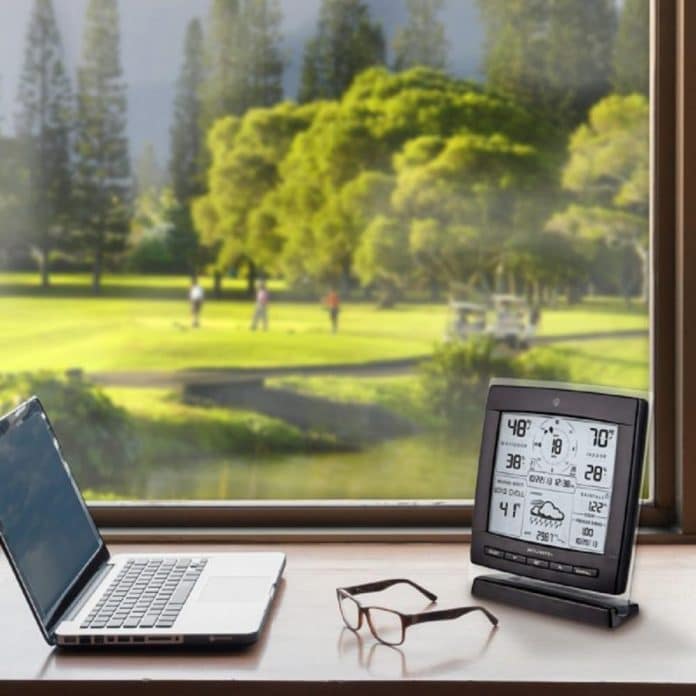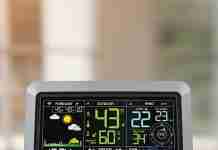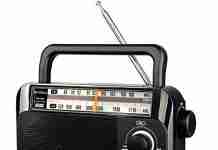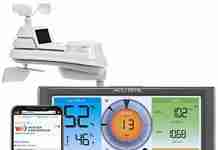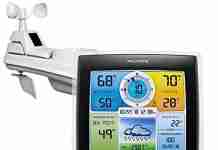Growing vegetables, herbs, and flowers in your garden is an exciting hobby for any green thumb.
But the success of your plants depends not only on soil quality and sunlight, but also on various environmental factors such as temperature, humidity, wind speed and direction, and more.
This is why many gardeners are opting to invest in a weather station. This technology provides real-time data about the environment in your garden that can help you make educated decisions about how to manage it.
This article will explore the various weather stations available and discuss their benefits for gardeners.
Review contents
The Different Types of Weather Stations
Different types of weather stations are available to suit different needs. The most common type of weather station is the home weather station, designed to be used in the home.
These weather stations usually include a thermometer, hygrometer, barometer, and anemometer. Some weather stations also include a rain gauge.
Other weather stations include portable weather stations, designed for mobile homes or RVs; commercial weather stations, designed for businesses; and scientific weather stations, designed for research facilities.
The Benefits of Weather Stations for Gardeners
If you are a gardener, you know that the weather can greatly impact your plants. From rain and snow to heat and humidity, the elements can wreak havoc on even the most well-tended garden.
A weather station can help you keep tabs on the conditions in your garden so that you can take steps to protect your plants from damage.
Here are some of the benefits of using a weather station in your gardening:
1. You can track rainfall levels.
2. You can monitor temperature swings.
3. You can get wind speed and direction readings.
4. You can keep an eye on humidity levels.
How to Use a Weather Station
If you want to start using a weather station to help with your gardening, you should know a few things.
First, you’ll need to find a spot for your weather station away from trees or buildings. This will ensure that your readings are accurate. You’ll also need to ensure that your weather station is level, so the sensors are reading correctly.
Once your weather station is set up, you can start taking readings. The most important readings for gardeners are temperature, humidity, and rainfall.
You can use these readings to help determine when to water your plants, how much fertilizer to use, and when to harvest your crops.
Using a weather station can make you a more efficient gardener and save time and money. So why not give it a try?
What to Look for When Buying a Weather Station
When buying a weather station, there are a few key things to look for:
1. Accuracy: You want a weather station that is accurate in its readings. This is especially important if you use the data to decide watering schedules, frost dates, etc.
2. Ease of use: You want an easy weather station to set up and use. Otherwise, you’ll spend more time fiddling with it than actually using it!
3. Durability: A weather station should withstand the elements, especially if you plan on leaving it outside. Look for one that is waterproof and windproof.
4. Battery life: If you plan on using your weather station regularly, you’ll want one with good battery life, so you don’t have to replace batteries constantly.
FAQ Weather Stations For Gardeners
If you’re a gardener, you know that the weather can make or break your plants. That’s why having a reliable weather station is essential to keeping your garden healthy and thriving.
But with so many different types and brands of weather stations on the market, it can be hard to know which one is right for you.
That’s why we’ve put together this FAQ to help you choose the best weather station for your needs.
What type of features do I need in a weather station?
The type of features you need in a weather station will depend on the information you want to track. For example, if you want to track temperature, humidity, and rainfall, you’ll need a station with sensors for each parameter.
Some stations also include wind speed and direction sensors, barometric pressure sensors, and even solar radiation sensors. It depends on what kind of data you want to collect.
What is the difference between wireless and wired weather stations?
Wireless weather stations are much easier to set up than wired ones since there are no cables to run from the sensors to the display unit. Wireless units typically use batteries for power, although some come with an AC adapter.
Wired units must be plugged into an AC outlet, but they usually provide more accurate readings than wireless units since they’re not affected by interference from other electronic devices.
How much does a typical weather station cost?
Weather stations can range in price from around $50 to over $1000, depending on the type and number of sensors included.
Generally speaking, more expensive units will have a larger selection of sensors and provide more comprehensive data than cheaper models.
HOW ACCURATE IS THE TEMPEST WEATHER SYSTEM?
There are a few things to consider when thinking about the accuracy of the Tempest Weather System. First, remember that weather is unpredictable and ever-changing, so no system can be 100% accurate all the time.
The Tempest Weather System is designed to be as accurate as possible and uses high-quality sensors to collect data.
Tempest also relies on machine learning to improve its predictions over time. So, while it may not be perfect, it is constantly improving.
In general, you can expect the Tempest Weather System to be more accurate than other weather forecasting methods, such as relying on forecasts from your local news station. However, there will always be some uncertainty when predicting the weather.
WHERE SHOULD I PLACE MY OUTDOOR SENSOR DEVICE?
If you want to purchase an outdoor sensor device for your weather station, remember a few things before deciding.
First, consider where you live and what the climate is like. If you live in an area with a lot of severe weather, you’ll want to ensure your sensor device is placed in a location that won’t be damaged by high winds or heavy rain.
Secondly, think about how often you’ll be using your weather station. If you plan on using it daily, you’ll want to place your sensor device in a convenient location. However, if you only plan on using your weather station occasionally, you can place your sensor device in a more discreet location.
WILL MY DATA BE SIMILAR TO NEARBY WEATHER STATIONS?
If you live in an area with many weather stations, your data will likely be similar to that of nearby weather stations.
However, your data may not be as similar if you live in an area with fewer weather stations. Additionally, local factors such as terrain and vegetation can affect the accuracy of your data.
GARDEN SMARTER
When it comes to gardening, there are a lot of factors to consider – sun, rain, wind, and temperature. It can be tough to keep track of everything, especially if you’re trying to do it yourself. That’s where weather stations come in.
Weather stations help you track the important environmental factors that affect your garden. They usually include a thermometer, hygrometer, anemometer, and barometer. Some also have rain gauges and solar radiation sensors. This information can help you decide when to water, when to fertilize, and when to harvest your crops.
There are a lot of different weather stations on the market, so it’s important to find one that meets your needs. Consider the features that are important to you and compare prices before making your final decision.
Which is better Acurite or La Crosse?
If you are looking for a weather station to help with your gardening, you may wonder which is better, Acurite or La Crosse.
Both brands offer quality weather stations that can provide useful information for gardeners. However, there are some differences between the two that you may want to consider before making a purchase.
Acurite weather stations are known for their accuracy and durability. They also offer a wide range of features, making them a good choice for those who want a comprehensive view of the weather conditions in their area.
La Crosse weather stations are also accurate and durable but tend to be less feature-rich than Acurite models. However, they are often more affordable, which may be an important consideration for some gardeners.
So, which is better, Acurite or La Crosse? Ultimately, the best weather station for you will depend on your specific needs and budget.
If you need a highly accurate and feature-rich station, Acurite is a good option. La Crosse may be a better choice if you are looking for a more affordable station with good accuracy and durability.
Is AcuRite a good weather station?
If you’re looking for a weather station to help you keep track of the conditions in your garden, AcuRite is a great option.
This brand offers a wide range of weather stations designed to be easy to use and provide accurate information.
AcuRite’s weather stations include temperature and humidity sensors and wind and rain gauges. Additionally, many of their models come with an LCD that shows all the current readings at a glance.
Are home weather stations worth it?
A home weather station can be a great addition to any gardener’s toolkit. There are many types of weather stations on the market, and they can range in price from around $30 to $300. But are they worth the money?
A few things to consider when deciding if a home weather station is worth the investment. The first is whether you need all the features a weather station offers. A basic model will suffice if you want to track temperature and rainfall. But if you want to track other environmental factors like humidity, wind speed, and barometric pressure, you might need to invest in a more expensive model.
Another thing to consider is how accurate you need the data to be. Some weather stations use sensors that are less accurate than others. If accuracy is important to you, you’ll want to ensure you buy a weather station with high-quality sensors.
Finally, think about how easy it is to use the weather station. Some models come with complex interfaces that can be difficult to navigate. If you want something simple and user-friendly, look for a model with a straightforward interface.
All these factors will help you decide if a home weather station is worth the investment.
Conclusion
Weather stations are a great way for gardeners to keep track of the weather and optimize their activities in the garden.
From measuring wind speed and direction to checking soil moisture levels, these instruments provide invaluable data that can help create an environment where your plants thrive.
With so many different types of stations available, one is sure to suit your needs perfectly.
Investing in a reliable weather station can save you time, money and effort when gardening – why wait any longer?

